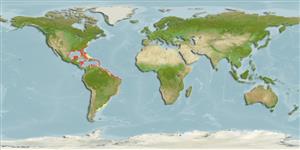Common names from other countries
>
Eupercaria/misc (Various families in series Eupercaria) >
Sparidae (Porgies)
Etymology: Archosargus: Greek, archo = anus + Latin , sargus = sea bream (Ref. 45335).
More on author: Linnaeus.
Environment: milieu / climate zone / depth range / distribution range
पारिस्थितिकी
समुद्री; खारा प्रवाल-भित्ति संयुक्त; गहराई सीमा 1 - 40 m (Ref. 115835). Subtropical; 22°C - 30°C; 41°N - 58°S, 98°W - 34°W
Western Atlantic: New Jersey, USA and northeastern Gulf of Mexico to Argentina (Ref. 4517). Absent from the Bahamas (Ref. 26938).
Length at first maturity / आकार / वज़न / Age
Maturity: Lm 8.0 range ? - ? cm
Max length : 33.0 cm TL पुल्लिंग / अलिंग; (Ref. 7251); common length : 20.0 cm TL पुल्लिंग / अलिंग; (Ref. 9626); अधिकतम प्रकाशित वज़न: 550.00 g (Ref. 9626); अधिकतम सूचित उम्र: 2.00 वर्षो (Ref. 3422)
पृष्ठीय रीढ़ (सम्पूर्ण) : 13; पृष्ठीय सौफट रेज़ (सम्पूर्ण) : 10 - 11; गुदा कांटा: 3; ऐनल सौफट रेज़: 10 - 11. Large intestine makes up 90% of digestive tract and is twice the standard length, on the average; the stomach with 7 digestive caeca attached near the pyloric region. Pelvic fin coloration totally or partially dark in males; orange colored in females. Large dark spot (about same size as eye) below lateral line just behind gill opening (Ref. 26938).
Commonly found over mud bottoms in mangrove sloughs and on vegetated sand bottoms, sometimes in brackish water and occasionally also in coral reef areas near mangroves. Feeds on benthic invertebrates (small bivalves, crustaceans), as well as on plant material.
Robins, C.R. and G.C. Ray, 1986. A field guide to Atlantic coast fishes of North America. Houghton Mifflin Company, Boston, U.S.A. 354 p. (Ref. 7251)
IUCN Red List Status (Ref. 130435)
CITES (Ref. 128078)
Not Evaluated
Threat to humans
Harmless
Human uses
मात्स्यिकी: व्यापारिक
साधन
Special reports
Download XML
इंटरनेट स्रोत
Estimates based on models
Preferred temperature (Ref.
115969): 22.8 - 28, mean 25.8 (based on 456 cells).
Phylogenetic diversity index (Ref.
82804): PD
50 = 0.6250 [Uniqueness, from 0.5 = low to 2.0 = high].
Bayesian length-weight: a=0.02042 (0.01730 - 0.02410), b=2.98 (2.94 - 3.02), in cm Total Length, based on LWR estimates for this species (Ref.
93245).
Trophic level (Ref.
69278): 2.9 ±0.1 se; based on diet studies.
लौटाव (Ref.
120179): ऊंचा, न्यूनतम जनसंख्या दुगनी समय अवलागत 15 महीने। (K=1.27; tm=0.4; tmax=2).
Fishing Vulnerability (Ref.
59153): Low vulnerability (23 of 100).
Climate Vulnerability (Ref.
125649): Moderate vulnerability (42 of 100).
